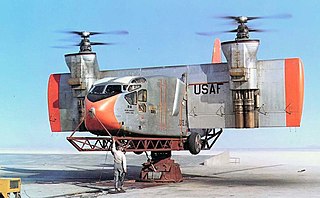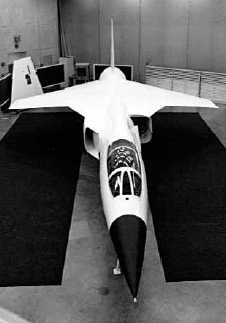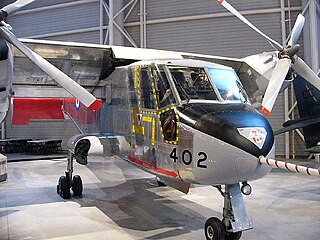
The Bell X-22 is an American V/STOL X-plane with four tilting ducted fans. Takeoff was to selectively occur either with the propellers tilted vertically upwards, or on a short runway with the nacelles tilted forward at approximately 45°. Additionally, the X-22 was to provide more insight into the tactical application of vertical takeoff troop transporters such as the preceding Hiller X-18 and the X-22's successor, the Bell XV-15. Another program requirement was a true airspeed in level flight of at least 525 km/h.

The Convair XFY Pogo was an experiment in vertical takeoff and landing (VTOL) tail-sitter. The Pogo had delta wings and three-bladed contra-rotating propellers powered by a turboprop engine. It was intended to be a high-performance fighter aircraft capable of operating from small warships. Landing the XFY-1 was difficult, as the pilot had to look over his shoulder while carefully working the throttle to land.

The Hiller X-18 was an experimental cargo transport aircraft designed to be the first testbed for tiltwing and V/STOL technology.

The Curtiss-Wright X-19, company designation Model 200, was an American experimental tiltrotor aircraft of the early 1960s. It was noteworthy for being the last aircraft of any kind manufactured by Curtiss-Wright.

The Lockheed CL-1200 Lancer was a late 1960s company-funded proposal for a fighter aircraft based on the Lockheed F-104 Starfighter. The CL-1200 was conceived and marketed mainly for and to non-US military services, as an export product. As such it would have competed with combat-proven designs like the Dassault Mirage III, McDonnell Douglas F-4 Phantom II, Mikoyan-Gurevich MiG-21, and Northrop F-5E Tiger II. The CL-1200 competed unsuccessfully against proposed fourth generation designs, under the US government's Lightweight Fighter program, which would eventually result in the General Dynamics F-16 and Northrop F-17 Cobra.
The EF 132 was a planned jet bomber, under development for the Luftwaffe during World War II. It was the last aircraft project development undertaken by Junkers during the war, and was the culmination of the Ju 287 design started in 1942.

The Canadair CL-84 "Dynavert", designated by the Canadian Forces as the CX-131, was a V/STOL turbine tiltwing monoplane designed and manufactured by Canadair between 1964 and 1972. Only four of these experimental aircraft were built with three entering flight testing. Two of the CL-84s crashed due to mechanical failures, with no fatalities occurring in either of the accidents. Despite the CL-84 being successful in the experimental and operational trials carried out between 1972 and 1974, none of the prospective customers placed any orders for the type.

The Lockheed XFV was an American experimental tailsitter prototype aircraft built by Lockheed in the early 1950s to demonstrate the operation of a vertical takeoff and landing (VTOL) fighter for protecting convoys.

The Lockheed XV-4 Hummingbird was a U.S. Army project to demonstrate the feasibility of using VTOL for a surveillance aircraft carrying target-acquisition and sensory equipment. It was designed and built by the Lockheed Corporation in the 1960s, one of many attempts to produce a V/STOL vertical take off/landing jet. Both prototype aircraft were destroyed in accidents.

The Ling-Temco-Vought (LTV) XC-142 was a tri-service tiltwing experimental aircraft designed to investigate the operational suitability of vertical/short takeoff and landing (V/STOL) transports. An XC-142A first flew conventionally on 29 September 1964, and on 11 January 1965, it completed its first transitional flight by taking off vertically, changing to forward flight and finally landing vertically. Its service sponsors pulled out of the program one by one, and it eventually ended due to a lack of interest after demonstrating its capabilities successfully.

The Doak VZ-4 was an American prototype Vertical Takeoff and Landing (VTOL) aircraft built in the 1950s for service in the United States Army. Only a single prototype was built, and the U.S. Army withdrew it from active trials in 1963.

The Ryan VZ-3 Vertiplane, also known by the company designation Ryan Model 92 was an American experimental vertical/short take-off (VSTOL) aircraft built by the Ryan Aeronautical Company for the United States Army.
Deflected slipstream is an approach to creating an aircraft that can take off and land vertically (VTOL), or at least with a very short runway (STOL). The basic principle is to deflect the slipstream from one or more propellers approximately 90 degrees, to create an upward thrust for vertical takeoff and a downward air cushion for landing. Once airborne, the flaps are retracted so the airplane can fly horizontally.

The Curtiss-Wright VZ-7 was a VTOL quadrotor helicopter aircraft designed by the Curtiss-Wright company for the US Army. Like the Chrysler VZ-6 and the VZ-8 Airgeep it was to be a "flying jeep".

The Dornier Do 29 was an experimental aircraft developed by Dornier Flugzeugwerke and the Deutsche Versuchsanstalt für Luftfahrt in the 1950s, used to test a tilting-propeller system for short takeoff and landing (STOL) aircraft. The concept was proved to be successful in flight testing; however, no further development of the system or aircraft was proceeded with, and at the conclusion of its test program the Do 29 was retired.

The Gwinn Aircar was a single-engined biplane with a cabin for two, designed in the US as a safe and simple private aircraft. Lacking a rudder, it had several unusual control features as well as an early tricycle undercarriage. Development was abandoned after a crash in 1938.
The Bede XBD-2 was an experimental short takeoff and landing (STOL) aircraft, with several novel features such as structural use of glass-fibre and aluminium honeycomb, a suction boundary layer control (BLC) system and fuselage-mounted twin engines driving a pusher configuration, shrouded single propeller. The sole example flew in the early 1960s in the United States.
The Chasle LMC-1 Sprintair is an all-metal, single-seat sports light aircraft designed in France in the early 1970s and intended to be built by aero clubs from plans.
The CPA 1 was a French twin-engined, parasol-winged bomber designed and built in the mid-1920s.

The Kaman K-16B was an experimental vertical-takeoff-and-landing aircraft that was constructed by Kaman Aircraft for the United States Navy in 1959 to evaluate the tiltwing concept. Converted from a Grumman Goose amphibian, the K-16B underwent extensive wind tunnel and tethered testing, but was not flown before the project was terminated in 1962.
















